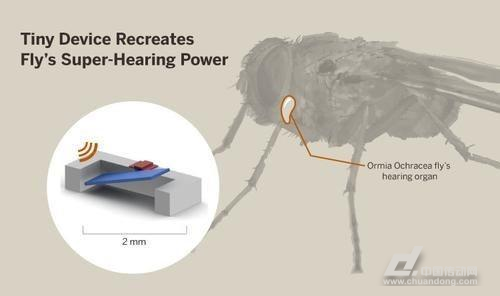The inspiration from the hearing of a fly inspired researchers to develop a new low-power microphone component that could hopefully pave the way for a new generation of smart battery-free hearing aids. Researchers at Cockerell School of Engineering at the University of Texas at Austin (UT) used a special hearing structure of a yellow parasitic fly (Ormia ochracea) to develop a new hearing aid that could only Emphasize the sound that the wearer wants to hear. This parasitic fly has a unique sound processing mechanism that can determine the direction of the sound within 2 degrees, and thus accurately locates the position of a beep in a tweet. Because of the speed limit of sound and the distance between human ears, in general, humans and other mammals can locate the source of sound, said Neal Hall, associate professor of electrical and computer engineering at the Cockerell School of Engineering who led the study. “When people look for an event based on sound, they use the limited speed of the sound,†he explained. “The sound is just a pressure wave that moves in the air at a limited speed. When you walk on the street, if you With a horn sound, you will know which way to turn, because the sound reaches one of your ears faster than the other. In the subconscious, your brain uses this data to identify sounds. The direction of the source." The diagram shows that researchers have inspired the sound processing mechanism of this parasitic fly to develop a low-power microphone assembly. Researchers at the University of Texas at Austin's Cockerell School of Engineering have developed miniature components that can be used to develop battery-free hearing aids. This new type of hearing aid allows the wearer to lock in the sound of interest and block the ambient noise. The research team observed that this particular type of parasite flies had different sound experiences, and Hall said that due to the special auditory structure of the fly, its sound was phase shifted by a kind of seesaw. This amplifies the time delay and allows the parasite to locate the source of the sound more accurately than other insects or animals. “Using this teeterboard principle, a parasitic fly can mechanically handle some minor differences,†he said. “The difference in sound pressure across the teeterboard makes it into a swinging motion, as if the children of different weights are sitting on both ends of the teeterboard. same." Using this structure as a model, the team at the University of Texas at Austin used silicon to create a 2mm wide microphone assembly that was almost like a parasite's hearing organ. The assembly consists of a flexible beam and a piezoelectric material that allows the research team to measure the deflection and rotation of the beam at the same time. These actions allow it to replicate the hearing of the fly. Neal pointed out that while similar components have been built in the past, the use of piezoelectric materials is a unique approach that allows the assembly to operate with very low power consumption by converting mechanical pressure into electrical signals. This low-power feature allows it to be used to develop new-generation hearing aids that do not require batteries. At present, wearers of hearing aids must often replace the battery for the device, which not only causes more costs, but may also affect the stability of the hearing aid. The way the device allows the user to hear the sound may also give the hearing aid another advantage. Hall stressed that because it can block some of the noise people do not necessarily want to hear. “In addition to locating the sound, the parasite also teaches us some tricks that allow small microphones to have built-in directionality,†he said. “This is very useful in some situations. For example, hearing aid wearers often feel that they have a high noise background. It is difficult to listen to clearly in an environment (such as a restaurant).To increase the volume in order to hear the sound of interest, the sound in the room will also be amplified. This can only be heard in a certain direction of interest and at the same time. A microphone component that filters out background noise can enhance the ability to understand the user's interest." The module is also suitable for military and defense applications, creating devices that enable soldiers to accurately locate the source of sound in the dark, especially in the absence of vision assistance. In fact, the US Department of Defense Advanced Research Projects Agency (DARPA) has sponsored Hall's research. To develop this microphone assembly, Hall and his research team plan to conduct years of research, focusing on increasing the frequency range to cover the full audio bandwidth. Of course, this component needs further design to be applicable to the packaging and processing of consumer products. BIOTEPT Farm-duty AC motors, also known as agricultural fan motors, have a high starting torque that allows them to start under large loads. They provide reliable service in dirty and rough environments and are commonly used for crop drying, running poultry equipment, manure pumps, augers, and conveyors. Motors have enclosures that help protect them from moisture, but they are not airtight or waterproof. Farm Duty Motor,Farm Duty Electric Motor,Brush Dc Motor,Dc Brush Motor Ningbo Biote Mechanical Electrical Co.,Ltd , https://www.biotept.com


